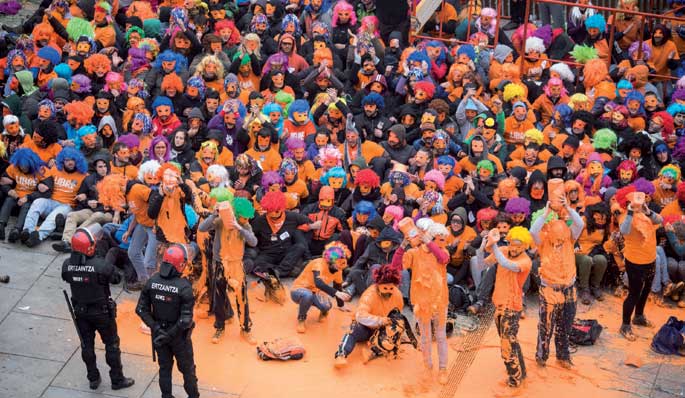Demonstrations of strength and violence
- The last seven young people condemned by the Spanish National High Court have been arrested in the Madrid anti-terrorist operation. Four of them were intercepted before the sentence was made public, and three managed to escape, according to the same source. After thousands of people took to the streets in defence of civil and political rights, the Ertzaintza evicted them last Monday from a wall in Vitoria-Gasteiz. The event has had a very special impact on domestic and international affairs, and new movements have taken place.

All indications indicate that the National Court has agreed to the request of the Ertzaintza evidenced by ARGIA: to authorize the arrest of convicted persons before the sentences were made public. They want to avoid the village walls, but it's a complicated path. On the one hand, family members have denounced that the arrests have been illegal and, on the other hand, that they have been detained without a final sentence and, although the sentence is difficult, if the Supreme Court acquitts a child it would be clearly acquitted and, finally, it has been shown that it is sufficient for the display of solidarity that one of the condemned seeks to prevent the escape to occur exactly the same extent.
Meanwhile, the civil and political rights movement is engaged in the domestic tasks of detainees. Free working groups, Harresiak and Eleak are engaged in the process of consolidation of the movement. From a dynamic that responds in each case, most groups in the Basque Country are becoming a movement in which they coordinate with each other. This has influenced the massive participation of the Vitoria-Gasteiz Wall.
On the road to disobedience, qualitative leaps have also been detected in the Alavesa capital. With masks to hinder the identification and faces drawn, disobedient willing to throw paint down the head, networks and chains to hinder eviction, related solidarity… arrests are becoming more difficult. This opens up new challenges for the movement. One of them is the comfort of finding their place in the wall to people with different levels of engagement, not feeling anyone outside of it.
To arrest three people, the Ertzaintza has brought out 300 people and has taken more than three hours to do so. Police violence in the CAV has been present in all the walls of the city, but in Vitoria-Gasteiz it has been especially highlighted. In the light of the day, agents have hit, poke and kicked in front of the gas chambers. 70 people have had to be cared for by volunteer nurses, including a young man who has had his leg moved out of the wall. On the other side of the scale, 17 agents have been injured in various ways. Most of the wounded Ertzaines fell or hit each other, so it is unpleasant to place all the wounded at the same level, as several media have done.
Following that of Vitoria-Gasteiz, there is one question left in the air: Why did the Ertzaintza act so violently? It is difficult to understand the approach and some keys still need it in secret. The police model itself has a great deal to do with the expansion of fear, as violence is one of the effective mechanisms to curb solidarity. It is, however, a political cost to hit the citizens so explicitly.
The walls make the leap to the courts. More than 20 people have formed a team of lawyers and attorneys in the city center. For the first time, evidence of attacks will be collected and complaints will be filed against identified Ertzainas.
.jpg)
Political use of torture
Is torture possible for the Basque Government? At the initiative of the Lakua Government, Pako Etxeberria ' s working group has collected over 3,600 allegations of torture from 1960 to the present day. Among them are those of these seven young people, whom the Ertzaintza has sent to prison, possibly also. Despite speaking out against torture, arresting young people, the Basque Government is giving political legitimacy to this practice, as the only basis for its arrest is the self-accusations they have subjected to torture, and therefore, in compliance with the law, the Basque Government has become one of the main actors legitimising the political use of torture.
The wishes and rights of a large part of the population have aroused new movements around the world from the bottom to the top when faced with the legality of the system: M15, Occupy Wall Street or Tahrir... Based on civil disobedience, the occupation of the public space and the demands for justice, in both cases popular phenomena are materialized. In Euskal Herria, the movement of the walls is also located in the same keys.
One of the most significant achievements of the last wall has been to place the theme of the seven young people in the scheme “justice vs. law”, beyond the identity scheme. On the other hand, the results have been gathered: the adhesion, the mood and the echo of many movements that are situated worldwide apart from partisan schemes. In addition to the support of its untiring regular colleagues, solidarity has come from different countries: The Spanish State, Greece, Germany, Australia, the United States, England, Ireland, the Netherlands, Russia, Ukraine, Italy… Although they have a great deal of complicity with groups calling for the reconstruction of the democratic system, since Euskal Herria, a great qualitative step has been taken in Vitoria. In the Spanish state, that of Vitoria-Gasteiz has also had a very broad follow-up and through the social networks many groups of the Vuelta M15 have shown their support. And also for the first time, matches like Equo, United Left, Podemos circles... And especially noteworthy is the criticism of ELA, which is the third union force within the Ertzaintza: “Non-violent passive resistance to injustice is a right and the time has come to reflect on the self-government of the Basque forces. It is becoming increasingly evident that self-government is limited to fulfilling the decisions taken by the powers of the State.”
The movement thus faces its main challenge: to move away from partisanship and to show itself as it is, a group of citizens willing to work in the defence of the rights of all.
.jpg)
New questions looking to the future
If the government, like EH Bildu, were in the hands of parties that share civil disobedience and the demand for popular walls, how would they manage the popular walls and the Ertzaintza?
The next big political issue will be the one facing the Herriko Tabernas. If the punishment comes, will the PNV be prepared to cooperate in the confiscation of 107 public premises from one of the main political forces in the Basque Country?
The movement of the walls has brought thousands of people together in the same public space. What can be done from mutual care to strengthen the feeling of community?
In the past year, numerous groups of free choice have been set up, most of them to respond to specific political judgments. Is this the germ of something else new beyond judgment?
Given the risk that the dynamics of popular walls will become politically untenable, will the Government take any steps to help put an end to these unjust sentences?
Popular Wall of Vitoria-Gasteiz, Topatu video:
Loiolako herri harresian atxilotu zituzten Esteban Orbegozo azpeitiarraren eta Beñat Hach Embarek ormaiztegiarraren kontrako epaiketak eta prozesuak eragin dituen gastuei aurre egiten laguntzeko bertso saioa izango da ostiralean, Azpeitiko Gaztetxean. Aitor Bizkarra,... [+]
Alcalá de Henareseko epaitegian izango da 50 lagunen kontrako epaiketa. Bost hilabeteko espetxe zigorra eskatzen dute bakoitzarentzat 2015eko epaiketa batean publiko gisa herri harresia irudikatzeagatik eta gazte auzipetuei babesa emateagatik.
Euskal gazteriaren aurkako Espainiako Estatuaren errepresioaren erdian, 2014ko irailaren 22an, Loiolako Basilikaren eskalinatan Herri Harresia egin genuen, epaiketara aurkeztu ez ziren bost euskal gazteak babesteko asmoz. Bertan izan ziren, beste ehunka herritarren moduan,... [+]
Esteban Orbegozo eta Beñat Hach Embarek zigortzea erabaki du Gipuzkoako Lurralde Auzitegiak, ertzain bat zauritu izana leporatuta. Dirua biltzeko hainbat ekimen antolatuko dituzte.
Donostiako Herri Harresian atxilotutako gazteen abokatuek Espainiako Zigor Kode berriaren arabera gradua jaisteko eskatu zuten, baina Auzitegi Gorenak ukatu egin du eta beraz, sei urteko kondena osotasunean bete beharko dute, espetxean jarraitzen duten bost gazteek.
IV Libre Topaketak egingo dituzte ostiralean eta larunbatean, Donostian, Eleak-Libre mugimenduak antolatuta, Mozal Legea salatu eta Aske Gunean atxilotutako gazteen askatasuna aldarrikatzeko.
Donostiako Askegunean atxilotu zuten Oier Lorente eta lau urteren ostean atera da kartzelatik; Segiko kide izateagatik 6 urteko espetxe zigorra ezarri zion Auzitegi Nazionalak.
Donostiako Askegunean atxilotu zuten Aitor Olaizola eta lau urteren ostean atera da kartzelatik, orotara sei urteko espetxe zigorrarekin ordainduta Segiko kide izatea egotzi izana. Ehunka lagun izan ditu zain Donostiako Alde Zaharrean, ongietorria emateko.
























